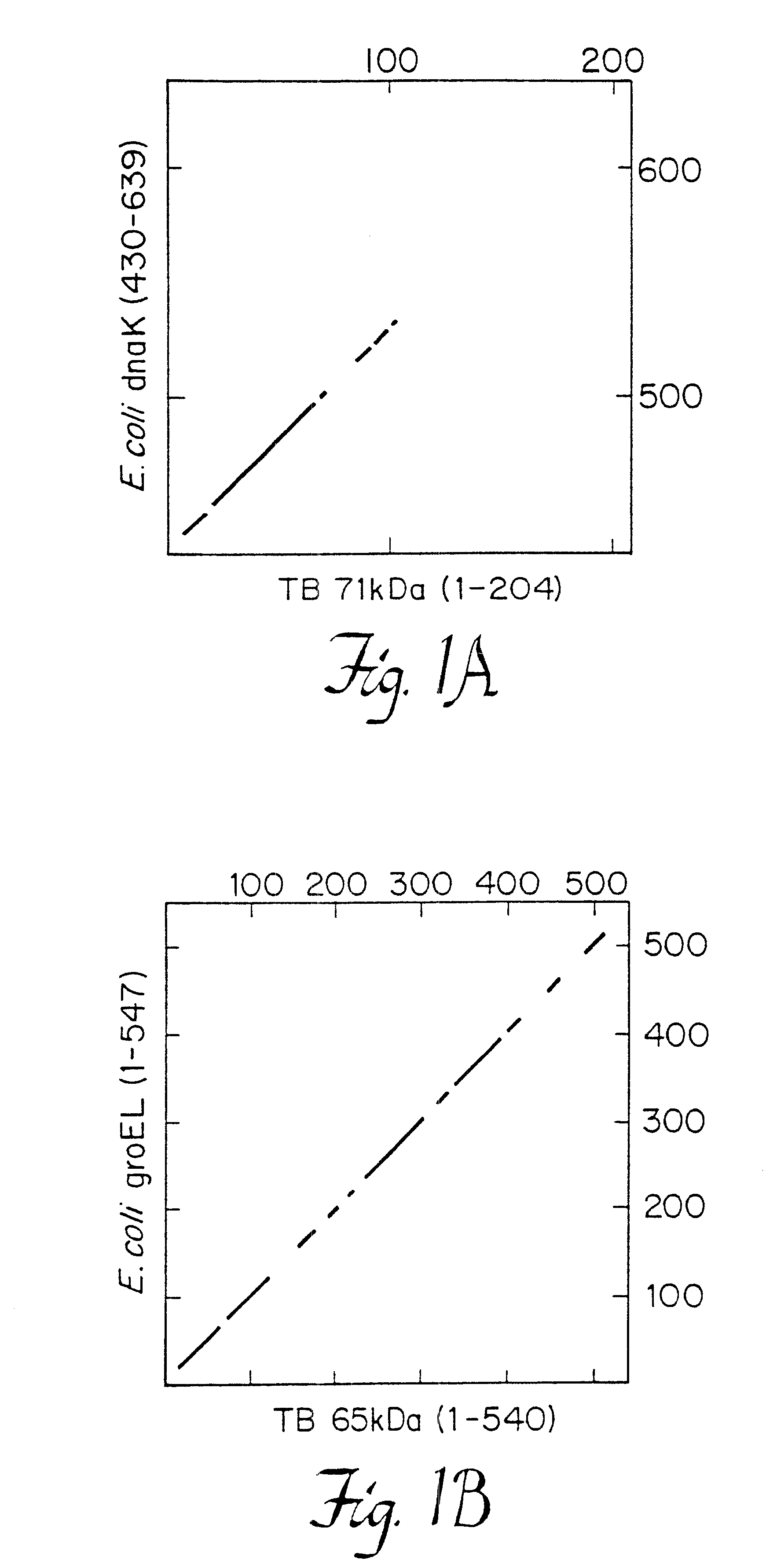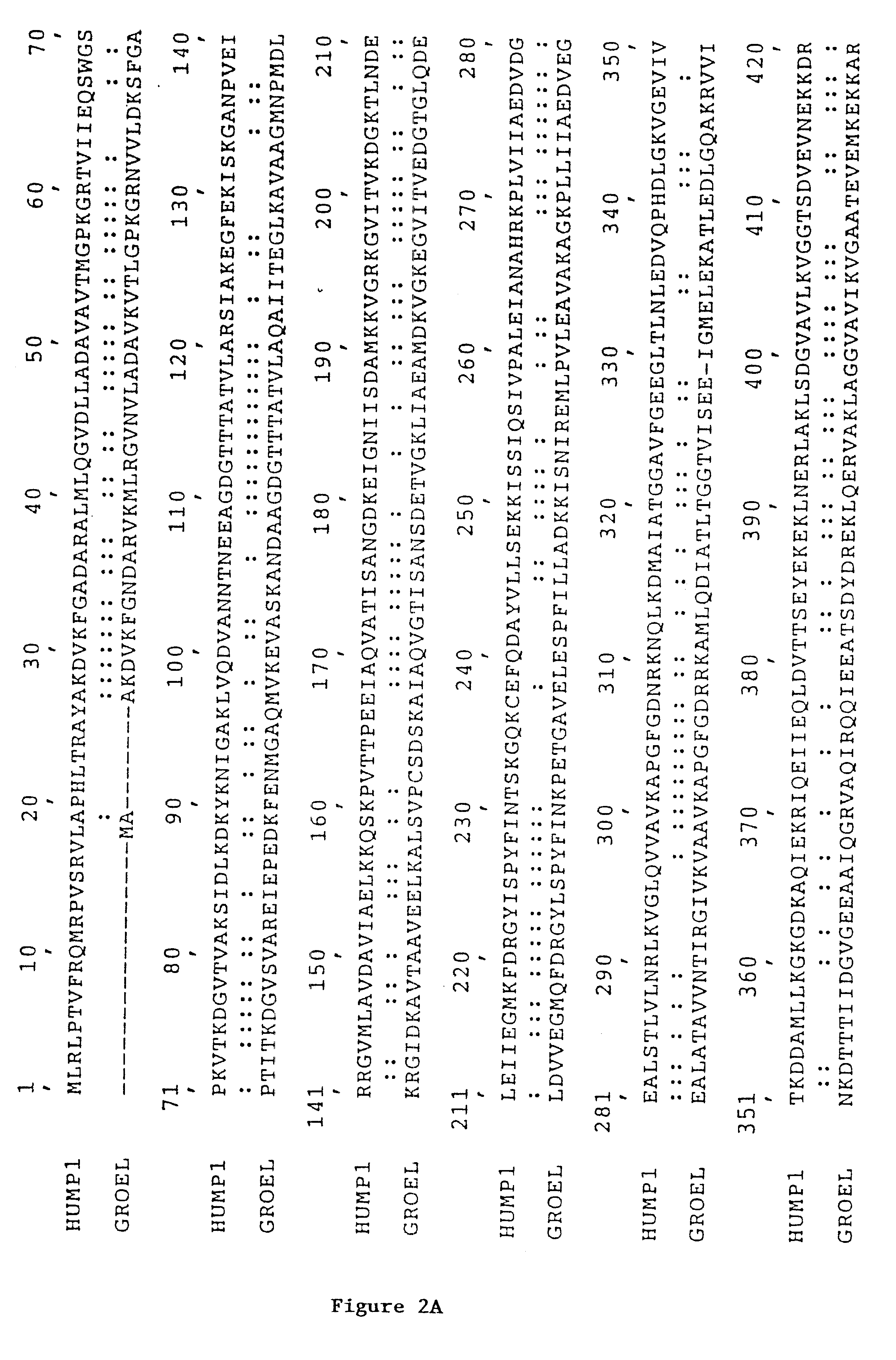Stress proteins and uses therefor
a technology of stress proteins and stress proteins, applied in the field of stress proteins and uses therefor, can solve problems such as presenting a significant global health problem, and achieve the effects of enhancing an individual's immune surveillance system, preventing or and reducing adverse effects of cancer cells
- Summary
- Abstract
- Description
- Claims
- Application Information
AI Technical Summary
Benefits of technology
Problems solved by technology
Method used
Image
Examples
example 1
Isolation and Characterization of Mycobacterial Stress Protein Antigens
Recombinant DNA Clones. The isolation and characterization of M. tuberculosis and M. leprae .lambda.gtll genomic DNA clones with murine monoclonal antibodies have been described. Husson, R. N. and Young, R. A., Proc. Natl. Acad. Sci., USA 84: 1679-1683 (1987); Young, R. A., et al., Nature (London) 316: 450-452 (1985). DNA was isolated from these clones and was manipulated by standard procedures. Davis, R. W., Advanced Bacterial Genetics: A Manual for Genetic Engineering (Cold Spring Harbor Lab., Cold Spring Harbor, N.Y.), (1980).
DNA Sequence Analysis. DNA was subcloned into vector M13mp18 or M13mp19 (New England Biolabs), as suggested by the supplier. Dideoxynucleotide chain-termination reactions and gel electrophoresis of the sequenced produced were as described. Davis, R. W., Advanced Bacterial Genetics: A Manual for Genetic Engineering (Cold Spring Harbor Lab., Cold Spring Harbor, N.Y.), (1980). DNA sequences ...
example 2
Construction of Stress Protein-fusion Vaccines for Use as Adjuvant-free Carriers in Immunizations
Recombinant Fusion Vectors. A series of stress protein fusion vectors for use in E. coli were constructed and are shown in FIG. 5. These vectors contain the T7 RNA polymerase promoter fused to the M. bovis BCG hsp70 gene or the M. bovis BCG hsp60 gene. The vectors also contain a polylinker with multiple cloning sites, permitting incorporation of a gene of interest so that the antigen encoded by that gene is expressed as a fusion protein with the stress protein. A subset of these vectors permit incorporation of the foreign gene with a coding sequence for a C-terminal 6-Histidine "tag" for ease of fusion protein purification. Thus far, recombinant clones have been generated that produce hsp70 proteins fused to HIV gag and HIV pol proteins.
Purification of stress protein fusions. Two strategies have been developed to purify the recombinant fusion proteins. The T7 system usually produces such...
example 3
Adjuvant-free Carrier Effect of hsp70 In Vivo
The stress protein fusion vector pKS70 (FIG. 6), containing the T7 RNA polymerase promoter, a polylinker and the Mycobacterial tuberculosis hsp70 gene, was constructed. The HIV p24 gag gene was subcloned into pKS70 using the Ndel and BamHI sites and the resulting pKS72 vector (FIG. 6) was used to produce the p24-hsp70 fusion protein in E. coli. The fusion protein was purified as inclusion bodies and further purified using ATP-agarose chromatography and MonoQ ion exchange chromatography.
The p24-hsp70 protein in phosphate buffered saline (PBS), in the absence of an adjuvant, was injected intraperitoneally into Balb / c mice. As controls, the p24 protein alone in PBS or the hsp70 protein alone in PBS was injected into different groups of mice. Three weeks later, the mice were boosted and finally, three weeks after the boost, the mice were bled. The anti-p24 antibody titer was then determined by ELISA. Mice injected with 25 pmoles of p24-hsp70 ...
PUM
| Property | Measurement | Unit |
|---|---|---|
| Composition | aaaaa | aaaaa |
| Molecular weight | aaaaa | aaaaa |
| Immunogenicity | aaaaa | aaaaa |
Abstract
Description
Claims
Application Information
 Login to View More
Login to View More - R&D
- Intellectual Property
- Life Sciences
- Materials
- Tech Scout
- Unparalleled Data Quality
- Higher Quality Content
- 60% Fewer Hallucinations
Browse by: Latest US Patents, China's latest patents, Technical Efficacy Thesaurus, Application Domain, Technology Topic, Popular Technical Reports.
© 2025 PatSnap. All rights reserved.Legal|Privacy policy|Modern Slavery Act Transparency Statement|Sitemap|About US| Contact US: help@patsnap.com



